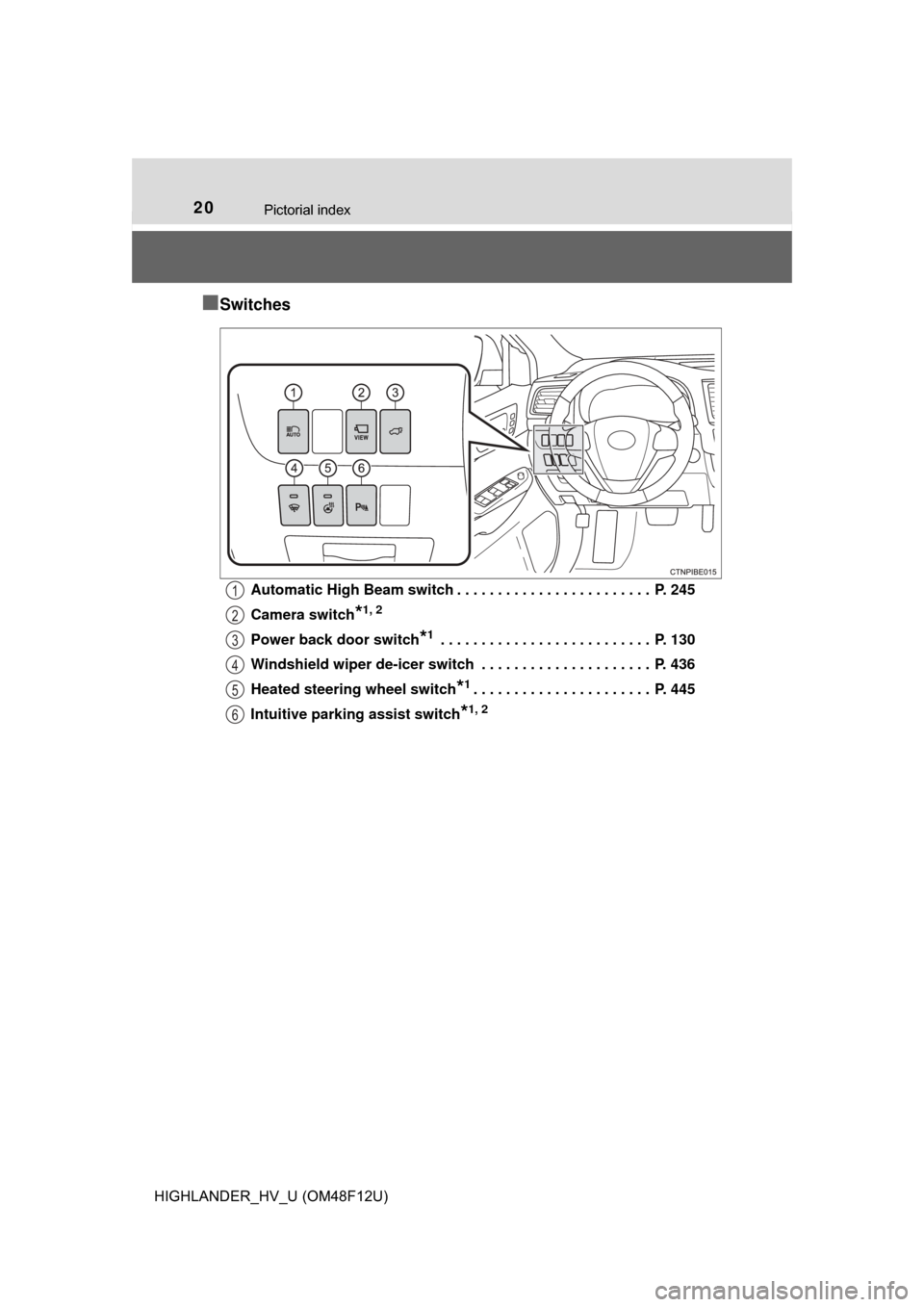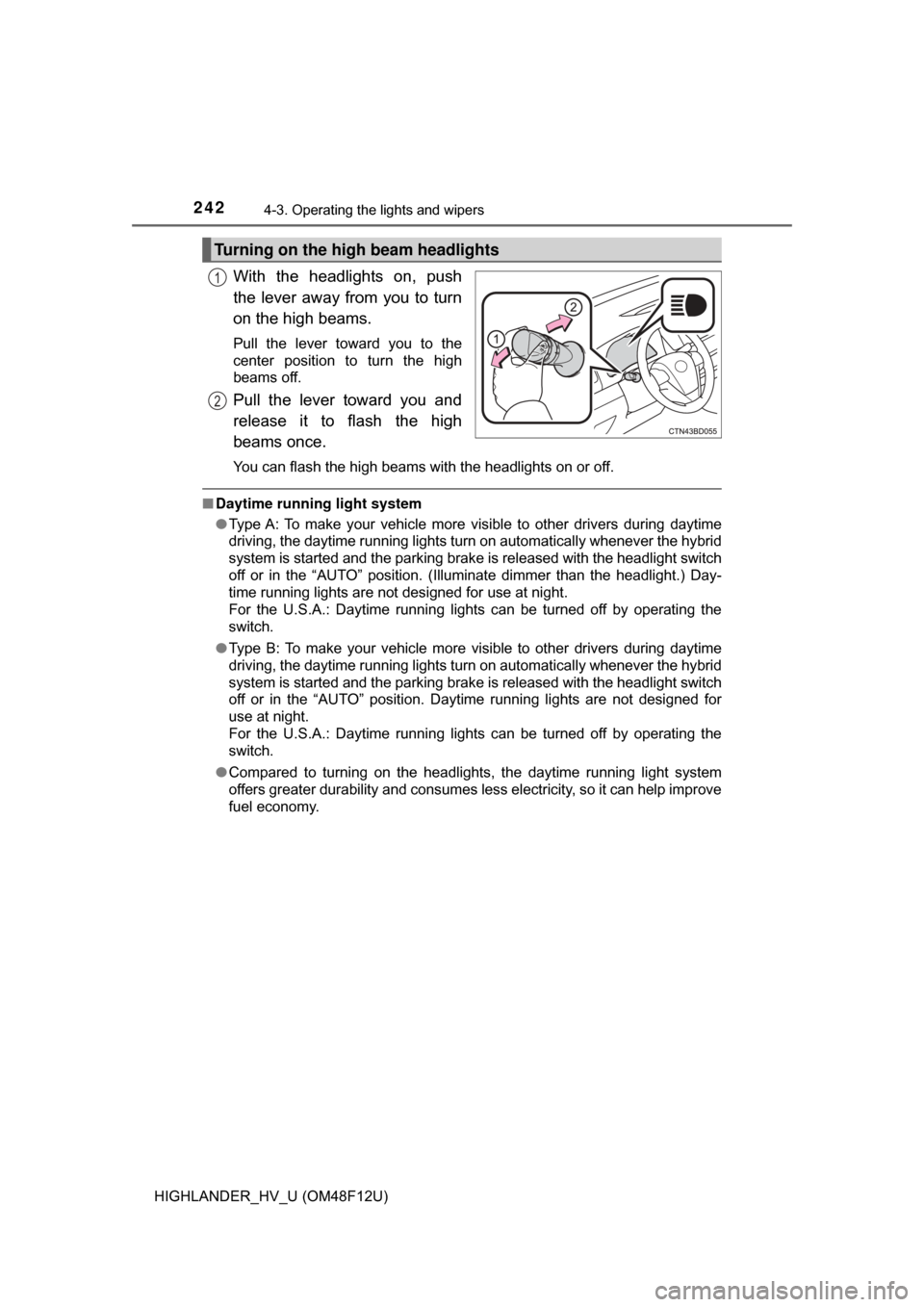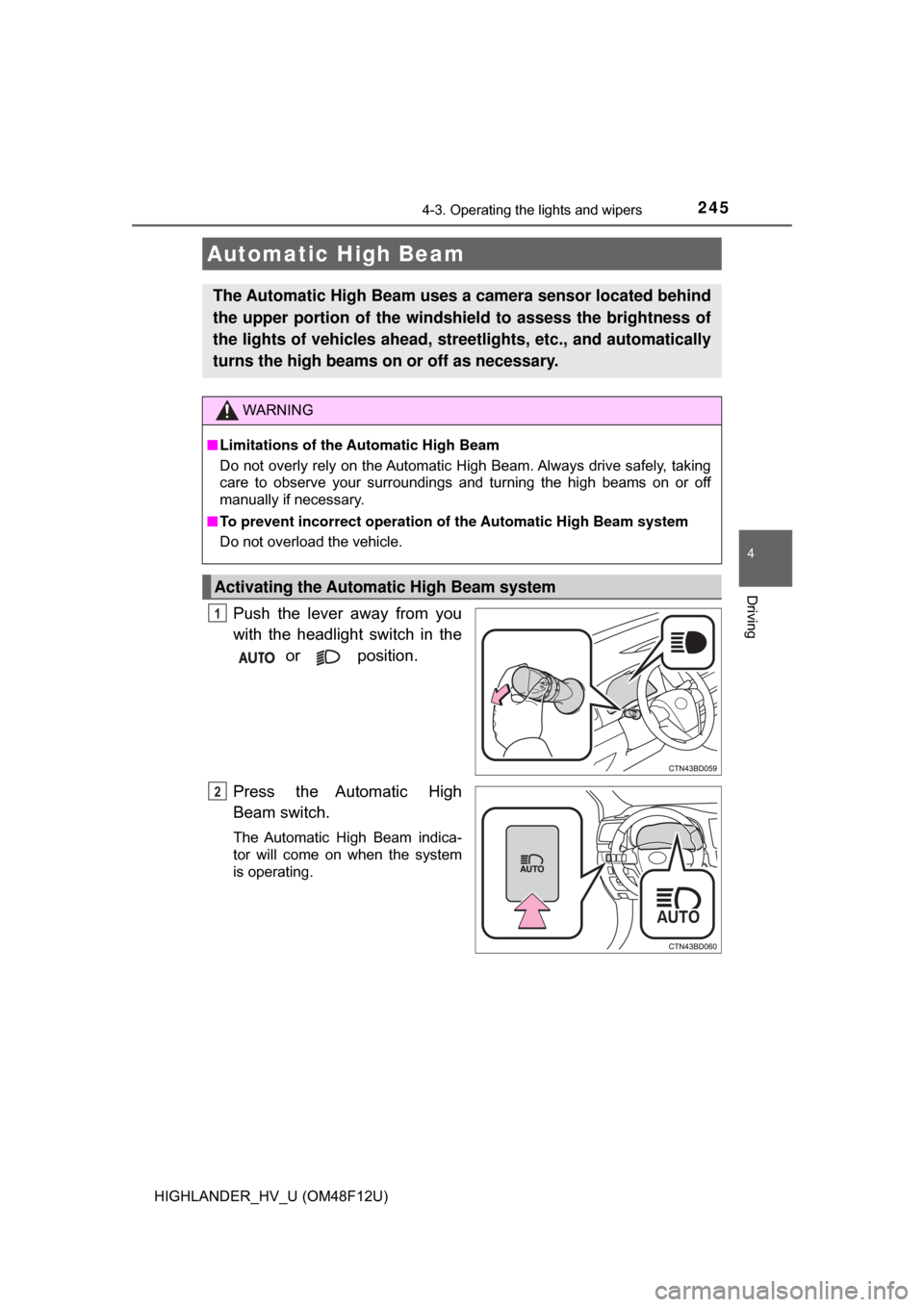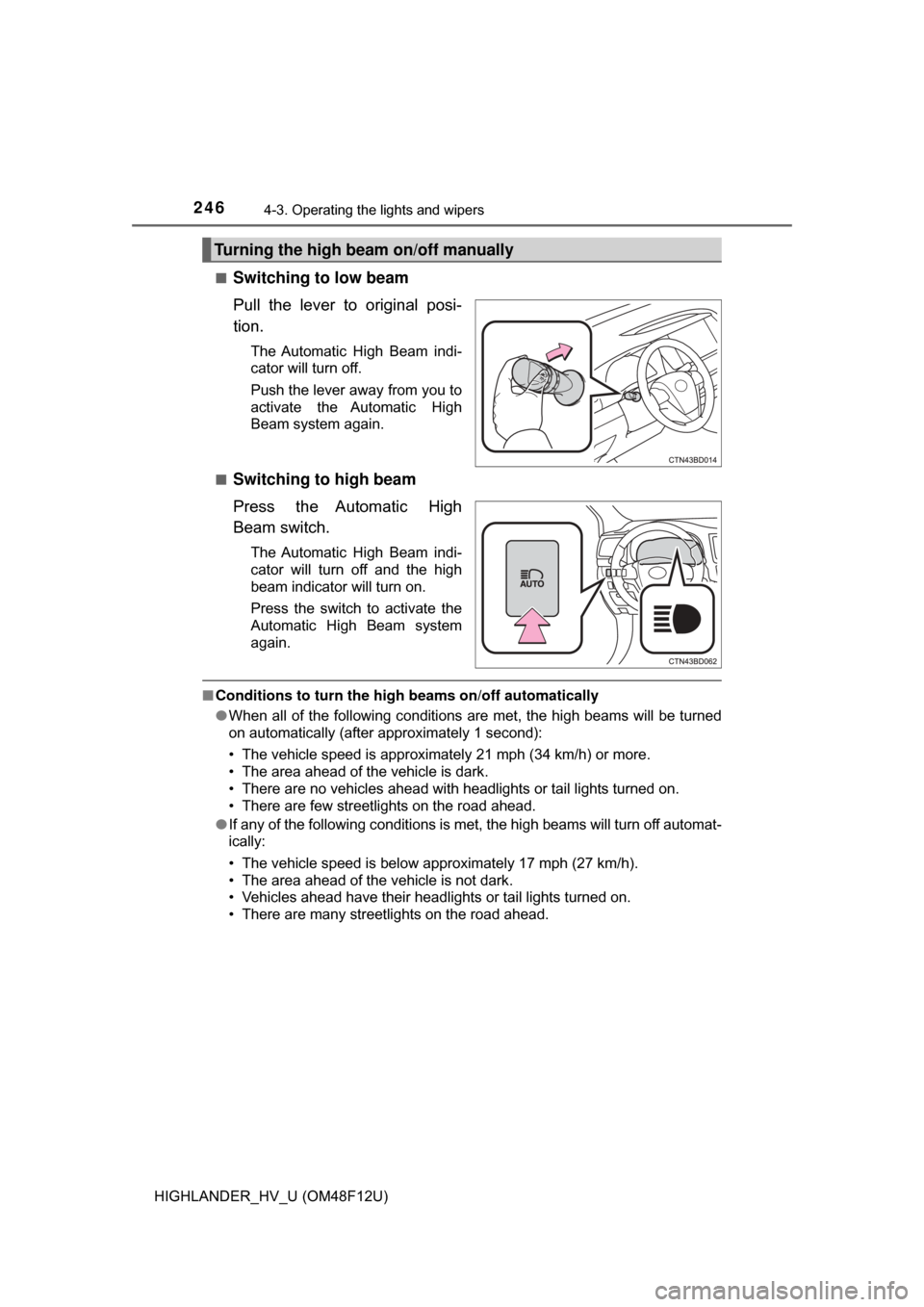2017 TOYOTA HIGHLANDER HYBRID high beam
[x] Cancel search: high beamPage 3 of 716

3
1
9 8 6 5
4
3
2
HIGHLANDER_HV_U (OM48F12U)
10
7
4-1. Before drivingDriving the vehicle ............. 192
Cargo and luggage............ 202
Vehicle load limits ............. 207
Trailer towing..................... 208
Dinghy towing.................... 224
4-2. Driving procedures Power (ignition) switch ...... 225
EV drive mode................... 231
Hybrid transmission........... 233
Turn signal lever................ 239
Parking brake .................... 240
4-3. Operating the lights and wipers
Headlight switch ................ 241
Automatic High Beam ....... 245
Fog light switch ................. 249
Windshield wipers and washer ............................ 250
Rear window wiper and washer ............................ 254 4-4. Refueling
Opening the fuel tank cap................................... 256
4-5. Using the driving support systems
Toyota Safety Sense P ...... 261
PCS (Pre-Collision System)..... 268
LDA (Lane Departure Alert
with steering control) ....... 282
Dynamic radar cruise control.............................. 292
Rear view monitor system ............................. 304
BSM (Blind Spot Monitor)......... 313
• BSM function ................. 318
• RCTA function ............... 322
Driving assist systems ....... 328
4-6. Driving tips Hybrid vehicle driving tips ................................... 334
Winter driving tips .............. 337
Utility vehicle precautions ...................... 341
4Driving
Page 20 of 716

20Pictorial index
HIGHLANDER_HV_U (OM48F12U)
■Switches
Automatic High Beam switch . . . . . . . . . . . . . . . . . . . . . . . . P. 245
Camera switch
*1, 2
Power back door switch*1 . . . . . . . . . . . . . . . . . . . . . . . . . . P. 130
Windshield wiper de-icer switch . . . . . . . . . . . . . . . . . . . . . P. 436
Heated steering wheel switch
*1. . . . . . . . . . . . . . . . . . . . . . P. 445
Intuitive parking assist switch
*1, 2
1
2
3
4
5
6
Page 101 of 716

1012. Instrument cluster
2
Instrument cluster
HIGHLANDER_HV_U (OM48F12U)
The indicators inform the driver of the operating state of the vehicle’s
various systems.
Indicators
Turn signal indicator
( →P. 239) LDA (Lane Departure
Alert with steering con-
trol) indicator
(
→P. 286)
(U.S.A.)
Headlight indicator
(→P. 241)*2, 3 Intuitive parking assist
indicator
(Canada)
Tail light indicator
(→P. 241) “ECO MODE” indicator
(
→P. 234)
Headlight high beam
indicator ( →P. 242)
*1, 8 Slip indicator ( →P. 330)
Automatic High Beam
indicator ( →P. 245)
*1VSC OFF indicator
(→P. 330)
*2Front fog light indicator
(→P. 249)*2BSM (Blind Spot Moni-
tor) indicator ( →P. 313)
Dynamic radar cruise
control (constant speed
control mode) indicator
( →P. 300)
*2, 5, 6BSM (Blind Spot Moni-
tor) outside rear view
mirror indicators
(→P. 313)
Dynamic radar cruise
control (vehicle-to-vehi-
cle distance control
mode) indicator
( →P. 296)
*7
Security indicator
(→P. 91, 93)
Dynamic radar cruise
control “SET”
indicator ( →P. 296, 300) “READY” indicator
(
→P. 225)
*1, 4PCS (Pre-Collision Sys-
tem) warning light
(→P. 272) EV indicator (
→P. 83)
Page 191 of 716

191
4Driving
HIGHLANDER_HV_U (OM48F12U)4-1. Before driving
Driving the vehicle ............. 192
Cargo and luggage ........... 202
Vehicle load limits ............. 207
Trailer towing..................... 208
Dinghy towing ................... 224
4-2. Driving procedures Power (ignition) switch ...... 225
EV drive mode .................. 231
Hybrid transmission........... 233
Turn signal lever................ 239
Parking brake .................... 240
4-3. Operating the lights and wipers
Headlight switch ................ 241
Automatic High Beam ....... 245
Fog light switch ................ 249
Windshield wipers and washer ............................ 250
Rear window wiper and washer ............................ 254 4-4. Refueling
Opening the fuel tank cap .................................. 256
4-5. Using the driving support systems
Toyota Safety Sense P ..... 261
PCS (Pre-Collision System) .... 268
LDA (Lane Departure Alert
with steering control) ....... 282
Dynamic radar cruise control ............................. 292
Rear view monitor system ............................ 304
BSM (Blind Spot Monitor) ........ 313
• BSM function ................ 318
• RCTA function .............. 322
Driving assist systems ...... 328
4-6. Driving tips Hybrid vehicle driving tips .................................. 334
Winter driving tips ............. 337
Utility vehicle precautions ..................... 341
Page 242 of 716

2424-3. Operating the lights and wipers
HIGHLANDER_HV_U (OM48F12U)
With the headlights on, push
the lever away from you to turn
on the high beams.
Pull the lever toward you to the
center position to turn the high
beams off.
Pull the lever toward you and
release it to flash the high
beams once.
You can flash the high beams with the headlights on or off.
■Daytime running light system
●Type A: To make your vehicle more visible to other drivers during daytime
driving, the daytime running lights turn on automatically whenever the hybrid
system is started and the parking brake is released with the headlight switch
off or in the “AUTO” position. (Illuminate dimmer than the headlight.) Day-
time running lights are not designed for use at night.
For the U.S.A.: Daytime running lights can be turned off by operating the
switch.
● Type B: To make your vehicle more visible to other drivers during daytime
driving, the daytime running lights turn on automatically whenever the hybrid
system is started and the parking brake is released with the headlight switch
off or in the “AUTO” position. Daytime running lights are not designed for
use at night.
For the U.S.A.: Daytime running lights can be turned off by operating the
switch.
● Compared to turning on the headlights, the daytime running light system
offers greater durability and consumes less electricity, so it can help improve
fuel economy.
Turning on the high beam headlights
1
2
Page 245 of 716

2454-3. Operating the lights and wipers
4
Driving
HIGHLANDER_HV_U (OM48F12U)
Push the lever away from you
with the headlight switch in the or position.
Press the Automatic High
Beam switch.
The Automatic High Beam indica-
tor will come on when the system
is operating.
Automatic High Beam
The Automatic High Beam uses a camera sensor located behind
the upper portion of the windshiel d to assess the brightness of
the lights of vehicles ahead, streetlights, etc., and automatically
turns the high beams on or off as necessary.
WARNING
■ Limitations of the Automatic High Beam
Do not overly rely on the Automatic High Beam. Always drive safely, taking
care to observe your surroundings and turning the high beams on or off
manually if necessary.
■ To prevent incorrect operation of the Automatic High Beam system
Do not overload the vehicle.
Activating the Automatic High Beam system
1
2
Page 246 of 716

2464-3. Operating the lights and wipers
HIGHLANDER_HV_U (OM48F12U)■
Switching to low beam
Pull the lever to original posi-
tion.
The Automatic High Beam indi-
cator will turn off.
Push the lever away from you to
activate the Automatic High
Beam system again.
■
Switching to high beam
Press the Automatic High
Beam switch.
The Automatic High Beam indi-
cator will turn off and the high
beam indicator will turn on.
Press the switch to activate the
Automatic High Beam system
again.
■ Conditions to turn the high beams on/off automatically
●When all of the following conditions are met, the high beams will be turned
on automatically (after approximately 1 second):
• The vehicle speed is approximately 21 mph (34 km/h) or more.
• The area ahead of the vehicle is dark.
• There are no vehicles ahead with headlights or tail lights turned on.
• There are few streetlights on the road ahead.
● If any of the following conditions is met, the high beams will turn off automat-
ically:
• The vehicle speed is below approximately 17 mph (27 km/h).
• The area ahead of the vehicle is not dark.
• Vehicles ahead have their headlights or tail lights turned on.
• There are many streetlights on the road ahead.
Turning the high beam on/off manually
Page 247 of 716

2474-3. Operating the lights and wipers
4
Driving
HIGHLANDER_HV_U (OM48F12U)■
Camera sensor detection information
●The high beams may not be automatically turned off in the following situa-
tions:
• When a vehicle suddenly appears from around a curve
• When the vehicle is cut in front of by another vehicle
• When vehicles ahead cannot be detected due to repeated curves, road
dividers or roadside trees
• When vehicles ahead appear in a faraway lane on a wide road
• When the lights of vehicles ahead are not on
● The high beams may be turned off if a vehicle ahead that is using fog lights
without its headlights turned on is detected.
● House lights, street lights, traffic signals, and illuminated billboards or signs
and other reflective objects may cause the high beams to change to the low
beams, or the low beams to remain on.
● The following factors may affect the amount of time taken for the high
beams to turn on or off:
• The brightness of the headlights, fog lights, and tail lights of vehicles
ahead
• The movement and direction of vehicles ahead
• When a vehicle ahead only has operational lights on one side
• When a vehicle ahead is a two-wheeled vehicle
• The condition of the road (gradient, curve, condition of the road surface,
etc.)
• The number of passengers and amount of luggage in the vehicle
● The high beams may turn on or off unexpectedly.
● Bicycles or similar vehicles may not be detected.
● In the following situations the system may not be able to correctly detect the
surrounding brightness level. This may cause the low beams to remain on
or the high beams to flash or dazzle pedestrians or vehicles ahead. In such
a case, it is necessary to manually switch between the high and low beams.
• When driving in inclement weather (heavy rain, snow, fog, sandstorms,
etc.)
• When the windshield is obscured by fog, mist, ice, dirt, etc.
• When the windshield is cracked or damaged
• When the camera sensor is deformed or dirty
• When the temperature of the camera sensor is extremely high
• When the surrounding brightness level is equal to that of headlights, tai\
l
lights or fog lights
• When headlights or tail lights of vehicles ahead are turned off, dirty, changing color, or not aimed properly
• When the vehicle is hit by water, snow, dust, etc. from a preceding vehi- cle
• When driving through an area of in termittently changing brightness and
darkness
• When frequently and repeatedly driving ascending/descending roads, or roads with rough, bumpy or uneven surfaces (such as stone-paved
roads, gravel roads, etc.)